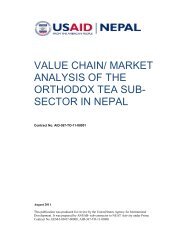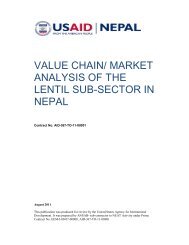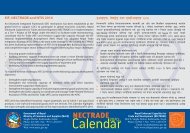value chain/ market analysis of the ginger sub-sector ... - Nepal Trade
value chain/ market analysis of the ginger sub-sector ... - Nepal Trade
value chain/ market analysis of the ginger sub-sector ... - Nepal Trade
- No tags were found...
You also want an ePaper? Increase the reach of your titles
YUMPU automatically turns print PDFs into web optimized ePapers that Google loves.
European Spice Association (ESA) Minimum Quality Standards for GingerTotal Ash(percentw/w) maxAcid Insoluble Ash(percentw/w) maxMoisture(percentw/w) maxVolatile oil (v/w) min(ISO) (ESA) (ISO) (ISO)8 2 12 1.5As per <strong>the</strong> ESA, <strong>the</strong> extraneous matter and foreign matter should not exceed 1 percent and 2percent respectively; should be free from live and/or dead insects, insect fragments, androdent contamination visible to naked eye. In microbial <strong>analysis</strong>, Salmonella must be absentin (at least) 25 gm <strong>of</strong> material, yeast and mould maximum up to 10 6 /g and E. coli maximumup to 10 3 /g. The European Union has fixed limits for aflatoxin and it should not exceed 10ppb in total.To be sold as organic, a product must be grown following organic agriculture practices andbe certified by an accredited certification body. The International Federation <strong>of</strong> OrganicAgriculture Movement (IFOAM) has established organic production, processing and tradingstandards, and tried to harmonize certification system worldwide. However, countries canhave <strong>the</strong>ir own standards such as Japanese Agriculture Standards (JAS) <strong>of</strong> Japan, EU organicstandards, US organic standards. To comply with organic standards and practices, <strong>the</strong>operator must document all farming and post-harvest activities including farm field map,field history, activity register, input records including purchase, output records includingsales, harvest records, storage records, pest control records, movement records, equipmentcleaning and labelling. All such documents must meet specific standards that are enumeratedin directives issued by <strong>the</strong> certification agencies.In <strong>the</strong> processing plant, <strong>the</strong> operator must present an organic handling plan which showshow contamination from prohibited materials and commingling with non-organic productswill be prevented. This includes a detailed description <strong>of</strong> <strong>the</strong> process, receiving and storage <strong>of</strong>ingredients and finished products, cleaning and sanitation <strong>of</strong> <strong>the</strong> processing equipment,facilities pest management, and a documentary paper trail that must permanently record all<strong>of</strong> <strong>the</strong> above.In India, <strong>the</strong> Bureau <strong>of</strong> Indian Standards (BIS) has AGMARK grading system for dry <strong>ginger</strong>and <strong>ginger</strong> powder. It categorizes <strong>ginger</strong> to different grades based on <strong>the</strong> size <strong>of</strong> rhizome,extraneous matter, lime content as calcium oxide and very light pieces.Annex 2: World Export Trend <strong>of</strong> Ginger (‘000 USD)Exporters 2006 2007 2008 2009 2010CAGR(percent) 8World 247,925 264,694 337,925 409,203 647,834 27.14China 168,155 153,299 212,024 281,637 434,920 26.82Nigeria 0 11,588 11,420 12,861 48,420 60.30Ne<strong>the</strong>rlands 13,430 16,179 21,470 23,289 36,830 28.69Thailand 8,998 14,891 26,019 24,932 28,679 33.618 CAGR: Compound Annual Growth RateValue Chain/Market Analysis-Ginger 41






